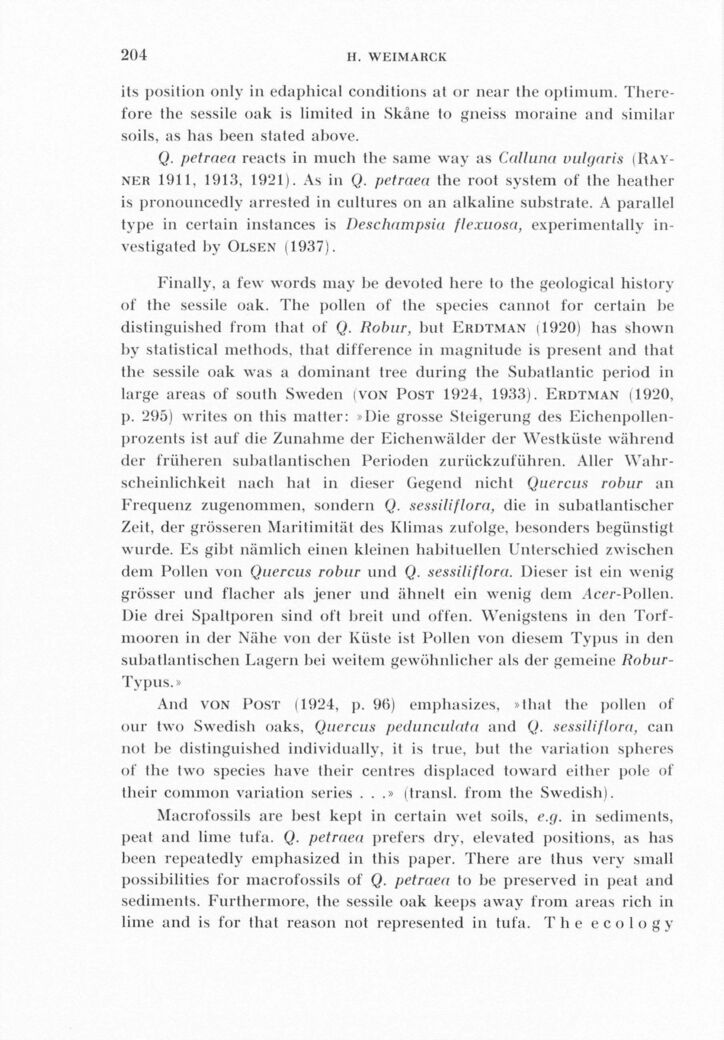
Full resolution (JPEG) - On this page / på denna sida - Sidor ...

<< prev. page << föreg. sida << >> nästa sida >> next page >>
Below is the raw OCR text
from the above scanned image.
Do you see an error? Proofread the page now!
Här nedan syns maskintolkade texten från faksimilbilden ovan.
Ser du något fel? Korrekturläs sidan nu!
This page has never been proofread. / Denna sida har aldrig korrekturlästs.
204
II. WEIMARCK
its position only in edaphical conditions at or near the optimum.
Therefore the sessile oak is limited in Skåne to gneiss moraine and similar
soils, as has been staled above.
Q. petraea reacts in much the same way as Calluna vulgaris
(Ray-ner 1911, 1913, 1921). As in Q. petraea the root system of the heather
is pronouncedly arrested in cultures on an alkaline substrate. A parallel
type in certain instances is Deschampsia flexuosa, experimentally
investigated by Olsen (1937).
Finally, a few words may be devoted here to the geological history
of the sessile oak. The pollen of the species cannot for certain be
distinguished from that of Q. Robur, but Erdtman (1920) has shown
by statistical methods, that difference in magnitude is present and that
the sessile oak was a dominant tree during the Subatlantic period in
large areas of south Sweden (von Post 1924, 1933). Erdtman (1920,
p. 295) writes oil this matter: »Die grosse Steigerung des
Eichenpollen-prozents ist auf die Zunahme der Eichenwälder der Westküste während
der früheren subatlantischen Perioden zurückzuführen. Äller
Wahr-scheinlichkeit nacli hat in dieser Gegend nicht Quercus robur an
Frequenz zugenommen, sondern Q. se&sMflora, die in subatlantischer
Zeit, der grösseren Maritimität des Klimas zufolge, besonders begiinstigt
wurde. Es gibt nämlich einen kleinen habil nellen Unterschied zwischen
dem Pollen von Quercus robur und Q. sessiliflora. Dieser ist ein wenig
grosser und flacher als jener und ähnelt ein wenig dem Acer-Pollen.
Die drei Spaltporen sind oft breit und often. Wenigstens in den
Torf-mooren in der Nälie von der Ivüste ist Pollen von diesem Typus in den
subatlantischen Lagern bei weitem gewöhnlicher als der gemeine
Robur-Typus.»
And von Post (1924, p. 96) emphasizes, »that the pollen of
our two Swedish oaks, Quercus pedunculata and Q. sessiliflora, can
not be distinguished individually, it is true, but the variation spheres
of the two species have their centres displaced toward either pole of
their common variation series ...» (transl. from the Swedish).
Macrofossils are best kept in certain wet soils, e.g. in sediments,
peat and lime tufa. Q. petraea prefers dry, elevated positions, as has
been repeatedly emphasized in this paper. There are thus very small
possibilities for macrofossils of Q. petraea to be preserved in peat and
sediments. Furthermore, the sessile oak keeps away from areas rich in
linie and is for that reason not represented in tufa. The ecology
<< prev. page << föreg. sida << >> nästa sida >> next page >>